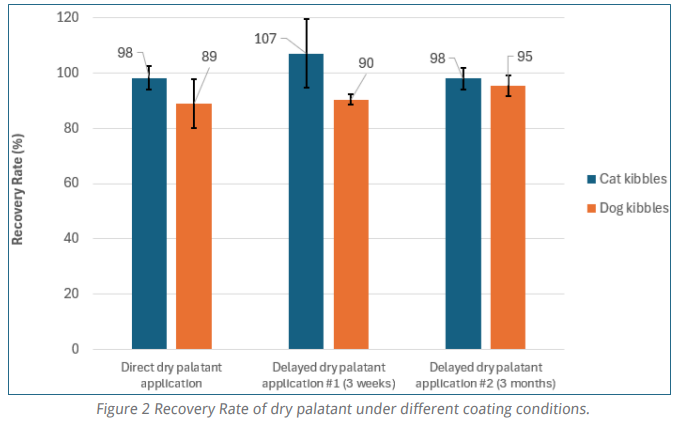In dry pet food manufacturing, the standard palatant application sequence typically follows three steps: (i) fat spraying, (ii) liquid palatant spraying, (iii) dry palatant application. Most fats must be heated (30-40 °C) to remain liquid. Once the fat is applied, palatants are usually layered on top, as depicted in Figure 1.
However, in certain situations –such as when the dry palatant is applied at a different location– it may be necessary to coat pre-fat-coated kibbles with dry palatants at a later stage.
This study investigates two key questions:
- Does applying dry palatant on room-temperature fat-precoated kibbles reduce palatant adhesion efficiency?
- Does this delayed application affect palatability?

EXPERIMENTAL DESIGN
Three coating conditions were tested:
- Direct dry palatant application: 3 % of fat was sprayed onto 3 % fat-precoated kibbles. The 3 % fatprecoated kibbles were produced in a standard way, with the fat being sprayed on warm dried kibbles exiting the dryer.There was a three-week interval between the two fat applications, and the latter was followed by an immediate dry palatant application.
- Delayed dry palatant application #1 (3 weeks delay): 6 % of fat was sprayed onto uncoated kibbles. After three weeks of storage, the dry palatant was applied.
- Delayed dry palatant application #2 (3 months delay): Same as Condition 2, but with a three-month storage period before applying the dry palatant.
Each condition was tested on both cat and dog kibbles, using dry palatant application levels of 1.5 % and 2.0 %.
The same poultry fat (applied at 35 °C) was used across all conditions.
Measurements
- Recovery Rate (RR): using analytical tracers, the actual percentage of dry palatant recovered on the kibbles was calculated.
- Palatability testing: carried out in AFB dog and cat kennels with 30 animals over two days; versus tests were analyzed using paired t-tests for dependent samples.
Marketplace
- Moisture content: controlled to ensure it did not influence palatability results (cat: 5.8 % ± 0.1, dog: 7.0 % ± 0.1).
- Crude fat content: verified for coating uniformity (cat: 11.9 % ± 0.3, dog: 10.4 % ± 0.3).
RESULTS
Recovery Rate of dry palatant
- Figure 2 illustrates the RR of the dry palatant for each condition.
- Key finding: the RR remained consistent across all conditions, indicating that at this fat level (6 %) dry palatant

Palatability results
Table 1 summarizes the results of the versus tests.
Key observations:
- the tests showed no statistically significant difference in palatability.
- one case showed a significant preference: cat kibbles with 1.5 % dry palatant, applied after 3 weeks.

CONCLUSION
- Delaying dry palatant application does not reduce adhesion efficiency.
- Palatability remains unchanged, except in one specific case.
These findings indicate that dry palatant application can be delayed by days, weeks, or even months after fat coating without compromising product performance or dry palatant adhesion.
This flexibility could be particularly useful when:
- applying dry palatants in a separate coating line (e.g., liquids in a batch coater, powders in a continuous coater).
- manufacturing two diets that differ only in the coating step.
- conducting trials in AFB facilities using customer-specific fat and application conditions.
Cautionary note: These results are based on a limited set of conditions (one type of fat, one type of kibbles, one dosage of fat…) and should not be taken as universally representative. They are intended to provide insights rather than conclusive evidence.
To learn more about this topic, or to speak with our Science & Technology experts, please reach out to your AFB Sales representative or afbinternational.com/contact.
Source: AFB International
You could be interested: Solutions for drugs and dietary supplements
About company

About company
WHAT WE DO
At AFB International, we develop and produce a full range of liquid and dry palatability enhancers. We use high-quality ingredients proven to optimize companion animal response and consumption.
Our specialty? Meeting your unique needs with custom support. Our worldwide staff of technical experts is ready to assist you with all aspects of palatability enhancement, from product development and testing to processing, logistics and more.
HOW WE WORK
Our successful customer relationships are built on clear, consistent communication—starting with really listening to understand your needs so we can respond quickly and effectively. And we keep listening. AFB scientists and technical service managers routinely travel to customer facilities to clearly understand the challenges at hand and the systems in place. Then we can recommend the best viable solutions.
OUR TEAM
AFB is dedicated to improving the health and wellness of companion animals worldwide through superior products and services. Our diverse, committed team works collaboratively to serve our clients. Get to know us—and let us know how we can help you!
HISTORY
AFB launched in 1986 and has grown to be the global science and technology leader in pet food palatability. Headquartered in St. Charles, Missouri, USA, AFB is a global company with state-of-the-art facilities in the United States, Argentina, Brazil, Mexico, the Netherlands, China, and Australia. AFB is a wholly owned subsidiary of Ensign-Bickford Industries, Inc., a privately held, family-owned, professionally managed technical business that traces its roots back more than 185 years.











































